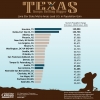Dec162014
Posted at 4:45 PM
Post by Dr. Mark Doms Under Secretary for Economic Affairs
Guest blog post by Mark Doms, Under Secretary for Economic Affairs
Our country – the public, businesses, NGOs, non-profits, academic institutions and governments at all levels – relies on the U.S. Department of Commerce’s Economic & Statistics Administration (ESA) to provide timely, relevant, and high-quality data about our population and economy so they can make better decisions. This is no easy task given the sheer magnitude of our nation – we have over 7 million employer- businesses, 320 million people, a Gross Domestic Product of over $17 trillion, and trillions of dollars in international trade. It can make your head spin. Additionally, keeping track of our economy and population is made all the more difficult because of the dynamism of our country: hundreds of thousands of new businesses start every year; tens of millions of people move; and new industries arise while others decline. On top of all of this, we are in the midst of a data revolution, with rapid advances in private-sector data availability, new data analysis tools, and ever more and changing ways to disseminate data.
As the Under Secretary for Economic Affairs, I ensure our people, programs, and policies are properly aligned and resourced to successfully perform our mission in this rapidly changing and increasingly complex environment. ESA’s three operating units; Commerce’s Office of the Chief Economist, the Bureau of Economic Analysis (BEA), and the Bureau of Census include a workforce of more than 10,000 dedicated professionals. In addition to our duties and challenges, ESA has been given another mission: to take the lead in achieving goals under the Data Pillar of the Department of Commerce’s Strategic Plan, working across all bureaus in Commerce to fulfill the imperative to “maximize the positive impacts of Commerce data on society.”
To be successful in both my traditional job as ESA Under Secretary and as a leader of the Data Pillar, I need a capable, nimble, leadership team with a diverse set of skills. None of us can be successful alone; instead we need to be members of strong teams committed to excellence. This post focuses on just one ESA team, that of my immediate office, which has been revamped in the past year. Team members were chosen and the positions created to meet a specific and diverse list of challenges, the most important being continuity, communication, coordination, and planning.
- Continuity: In order to ensure new initiatives won’t slow during political leadership transitions, and that the Under Secretary receives the best possible guidance, we selected Ken Arnold to fill the Deputy Under Secretary position last spring. He has deep Executive Branch experience, having worked many years at the Department of Defense and in a management role at ESA for the past 3 ½ years.
To help ensure ESA-wide resources are aligned with mission priorities, Mr. Arnold is augmented by Brad Burke, our CFO and Director of Administration. Brad joined our team last year as a seasoned executive with extensive experience elsewhere in Commerce and at the Department of Homeland Security. He also brings business perspectives as a former private-sector executive who successfully ran multi-billion dollar corporate investment portfolios and an entrepreneur who launched his own successful small business enterprise.
- Communication: Communicating ESA’s mission and data requires engaging with a huge and diverse stakeholder community: thousands, if not millions, of businesses use our data; tens of thousands of local governments and many federal agencies depend on the information we provide; NGOs and the media use our information to better achieve their missions; and the general public frequently seeks our data. We need a team that can communicate with this vast audience. This fall we named Burton Reist as our Director of External Affairs, a senior leader and communicator from Census who has decades of experience in the statistical and communications realm, to manage this critical function.
- Coordination: Data spans all bureaus within the Commerce Department and across the Federal government. To help coordinate across agencies, and with the legislative branch, ESA now has a Chief of Staff, Austin Durrer, to help ensure Administration priorities and legislative efforts support our important mission objectives. Austin comes to us from Capitol Hill where he served for over a decade, including as Chief of Staff to a senior member on the Appropriations Committee.
- Planning: ESA develops and monitors the strategic plans within ESA and the Data Pillar. Additionally, complex data policy issues have arisen in recent years and the number of data-related policy issues is likely to grow and become even more complex. To address these challenges, we are on track to have a Director of Policy and Planning start in early 2015, who will report to the Deputy Under Secretary to ensure ambitious policy and planning activities remain focused and sustainable over the long run.
The new team cannot by itself achieve ESA’s dual missions. But they already have had a positive impact. Our exceptional professionals are coalescing around these leaders’ energy, focus, and initiative. Through their efforts, our professionals are gaining a better understanding of how their work directly links to our strategic efforts, enabling supervisors and employees alike to determine what helps us achieve results and what detracts from our efforts. These new leaders are also creating clarity of purpose by functioning as conduits of information between Departmental leadership and our trusted leaders in BEA, Census, and the Office of the Chief Economist, facilitating decisions, clearing away obstacles, and ensuring effective communications up, down, and across the Department.
We’ve got the mentality of a start-up, and lift off on ESA’s revamped mission has only just begun. So stay tuned -- together with the exceptional leaders and professionals throughout ESA, we are working to deliver not only our renowned flagship products and services, but also to bring you new, better data on our people and our economy.


